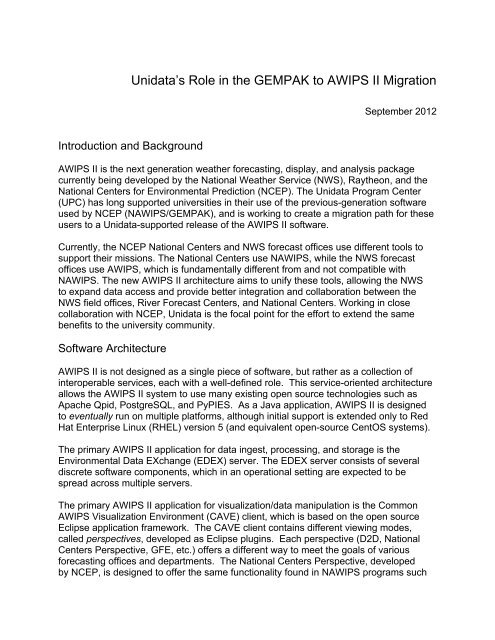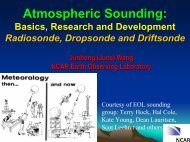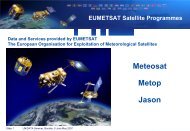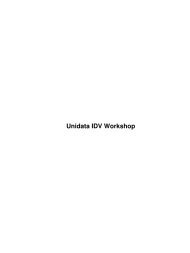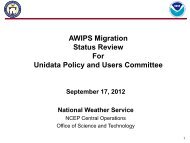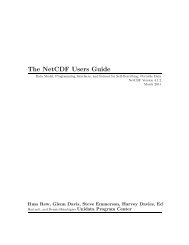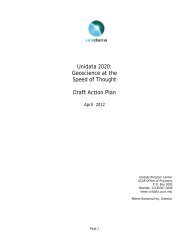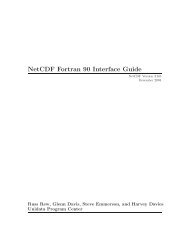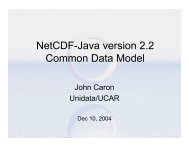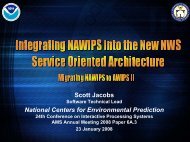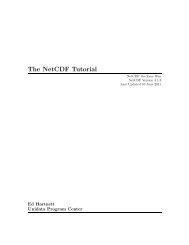AWIPS II Whitepaper - Unidata
AWIPS II Whitepaper - Unidata
AWIPS II Whitepaper - Unidata
Create successful ePaper yourself
Turn your PDF publications into a flip-book with our unique Google optimized e-Paper software.
<strong>Unidata</strong>’s Role in the GEMPAK to <strong>AWIPS</strong> <strong>II</strong> Migration<br />
September 2012<br />
Introduction and Background<br />
<strong>AWIPS</strong> <strong>II</strong> is the next generation weather forecasting, display, and analysis package<br />
currently being developed by the National Weather Service (NWS), Raytheon, and the<br />
National Centers for Environmental Prediction (NCEP). The <strong>Unidata</strong> Program Center<br />
(UPC) has long supported universities in their use of the previous-generation software<br />
used by NCEP (N<strong>AWIPS</strong>/GEMPAK), and is working to create a migration path for these<br />
users to a <strong>Unidata</strong>-supported release of the <strong>AWIPS</strong> <strong>II</strong> software.<br />
Currently, the NCEP National Centers and NWS forecast offices use different tools to<br />
support their missions. The National Centers use N<strong>AWIPS</strong>, while the NWS forecast<br />
offices use <strong>AWIPS</strong>, which is fundamentally different from and not compatible with<br />
N<strong>AWIPS</strong>. The new <strong>AWIPS</strong> <strong>II</strong> architecture aims to unify these tools, allowing the NWS<br />
to expand data access and provide better integration and collaboration between the<br />
NWS field offices, River Forecast Centers, and National Centers. Working in close<br />
collaboration with NCEP, <strong>Unidata</strong> is the focal point for the effort to extend the same<br />
benefits to the university community.<br />
Software Architecture<br />
<strong>AWIPS</strong> <strong>II</strong> is not designed as a single piece of software, but rather as a collection of<br />
interoperable services, each with a well-defined role. This service-oriented architecture<br />
allows the <strong>AWIPS</strong> <strong>II</strong> system to use many existing open source technologies such as<br />
Apache Qpid, PostgreSQL, and PyPIES. As a Java application, <strong>AWIPS</strong> <strong>II</strong> is designed<br />
to eventually run on multiple platforms, although initial support is extended only to Red<br />
Hat Enterprise Linux (RHEL) version 5 (and equivalent open-source CentOS systems).<br />
The primary <strong>AWIPS</strong> <strong>II</strong> application for data ingest, processing, and storage is the<br />
Environmental Data EXchange (EDEX) server. The EDEX server consists of several<br />
discrete software components, which in an operational setting are expected to be<br />
spread across multiple servers.<br />
The primary <strong>AWIPS</strong> <strong>II</strong> application for visualization/data manipulation is the Common<br />
<strong>AWIPS</strong> Visualization Environment (CAVE) client, which is based on the open source<br />
Eclipse application framework. The CAVE client contains different viewing modes,<br />
called perspectives, developed as Eclipse plugins. Each perspective (D2D, National<br />
Centers Perspective, GFE, etc.) offers a different way to meet the goals of various<br />
forecasting offices and departments. The National Centers Perspective, developed<br />
by NCEP, is designed to offer the same functionality found in N<strong>AWIPS</strong> programs such
as NMAP2, NSHARP, NTRANS, and NWX. The CAVE client is typically installed on<br />
a workstation separate from the EDEX components, but the UPC is investigating the<br />
possibility that CAVE and EDEX software can run on the same workstation.<br />
Status and Schedule for the National Weather Service<br />
Raytheon, contracted by the NWS to develop <strong>AWIPS</strong> <strong>II</strong>, provides regular releases and<br />
updates to the NWS for testing and evaluation. <strong>Unidata</strong> subsequently receives updates<br />
of the source code and the development environment for all major <strong>AWIPS</strong> <strong>II</strong> releases<br />
through the NWS Silver Spring office and NCEP.<br />
The <strong>AWIPS</strong> to <strong>AWIPS</strong> <strong>II</strong> transition at the NWS began in Fall 2011 and is expected to<br />
be completed in early 2013 (to date, WFOs at Omaha, Boulder, Norman and Houston<br />
have installed <strong>AWIPS</strong> <strong>II</strong>). The N<strong>AWIPS</strong> to <strong>AWIPS</strong> <strong>II</strong> transition at the National Centers<br />
will occur on a center-by-center basis, beginning in early 2013, and is expected to be<br />
completed early in 2014.<br />
NCEP has stated that they intend to continue supporting GEMPAK code until further<br />
notice, and GEMPAK routines are being reworked to ensure that GEMPAK libraries<br />
can read from the <strong>AWIPS</strong> <strong>II</strong> database, as well as from decoded GEMPAK format files.<br />
The CAVE client is currently able to read GEMPAK-formatted grid files, and support for<br />
GEMPAK-formatted surface and upper-air files is anticipated in early 2013.<br />
<strong>Unidata</strong>’s Role<br />
<strong>Unidata</strong> is collaborating with NCEP and the NWS to prepare <strong>AWIPS</strong> <strong>II</strong> for nonoperational<br />
use by the university community. To provide redundancy when used<br />
operationally by NWS forecast offices and NCEP National Centers, <strong>AWIPS</strong> <strong>II</strong><br />
components are distributed and clustered on multiple servers, a resource requirement<br />
that is less practical for universities and individuals. Of primary interest is performance<br />
of the EDEX server when installed on a single server rather than clustered among four.<br />
The Java Virtual Machines which comprise EDEX handle data ingest, processing, and<br />
read/write access to processed data storage, but long data processing latencies have<br />
been difficult to avoid when these JVMs are run in parallel on a single machine and<br />
ingesting a full suite of data via the <strong>Unidata</strong> Internet Data Distribution (IDD) network.<br />
Recent work by <strong>Unidata</strong> has improved the performance of <strong>AWIPS</strong> <strong>II</strong> data flow on singleserver<br />
EDEX installations. Changes to Raytheon’s configuration of the Local Data<br />
Manager (LDM) have been made in recent months, allowing <strong>Unidata</strong> to run current<br />
<strong>AWIPS</strong> <strong>II</strong> releases on a standalone server. Data ingest latencies, disk read and write<br />
times, and system load have been reduced to the point where <strong>Unidata</strong> considers a<br />
single-server <strong>AWIPS</strong> <strong>II</strong> system, or a single-server EDEX supporting multiple CAVE
clients, to be real possibilities for academic (non-operational) use.<br />
The UPC is conducting an ongoing beta testing program involving a small number<br />
of universities identified as core members of our community. Through the feedback<br />
received from these institutions and the continued work in Boulder, the UPC is<br />
preparing to offer full support services to the <strong>Unidata</strong> community throughout the<br />
N<strong>AWIPS</strong> to <strong>AWIPS</strong> <strong>II</strong> transition.<br />
In addition to the UPC developers taking part in NWS-directed <strong>AWIPS</strong> <strong>II</strong> training,<br />
documentation and training materials are being created to assist our users in the<br />
installation, configuration, and general understanding of the <strong>AWIPS</strong> <strong>II</strong> system, specific<br />
to the anticipated needs of the community. The UPC is incorporating an <strong>AWIPS</strong><br />
<strong>II</strong> section into the annual N<strong>AWIPS</strong>/GEMPAK training workshop to provide current<br />
N<strong>AWIPS</strong> users with an introduction to the software before migration begins.<br />
Additionally, the UPC is exploring the feasibility of hosting and managing a code<br />
repository for open source <strong>AWIPS</strong> <strong>II</strong> software development by community members,<br />
separate from the baseline maintained by Raytheon and the NWS.<br />
Summary<br />
The UPC continues to play an active role in the development and testing of <strong>AWIPS</strong> <strong>II</strong>, in<br />
cooperation with Raytheon, the NWS, and NCEP. In-house work, along with a growing<br />
beta testing program involving the <strong>Unidata</strong> community, is bringing us closer to the goal<br />
of providing a functional, fast, and well-documented software release for community<br />
members.<br />
Additional <strong>AWIPS</strong> <strong>II</strong> migration information and news, including frequently asked<br />
questions, can be found online at http://www.unidata.ucar.edu/software/awips2/<br />
<strong>Unidata</strong> Program Center<br />
UCAR Office of Programs<br />
P.O. Box 3000<br />
Boulder, CO 80307-3000


